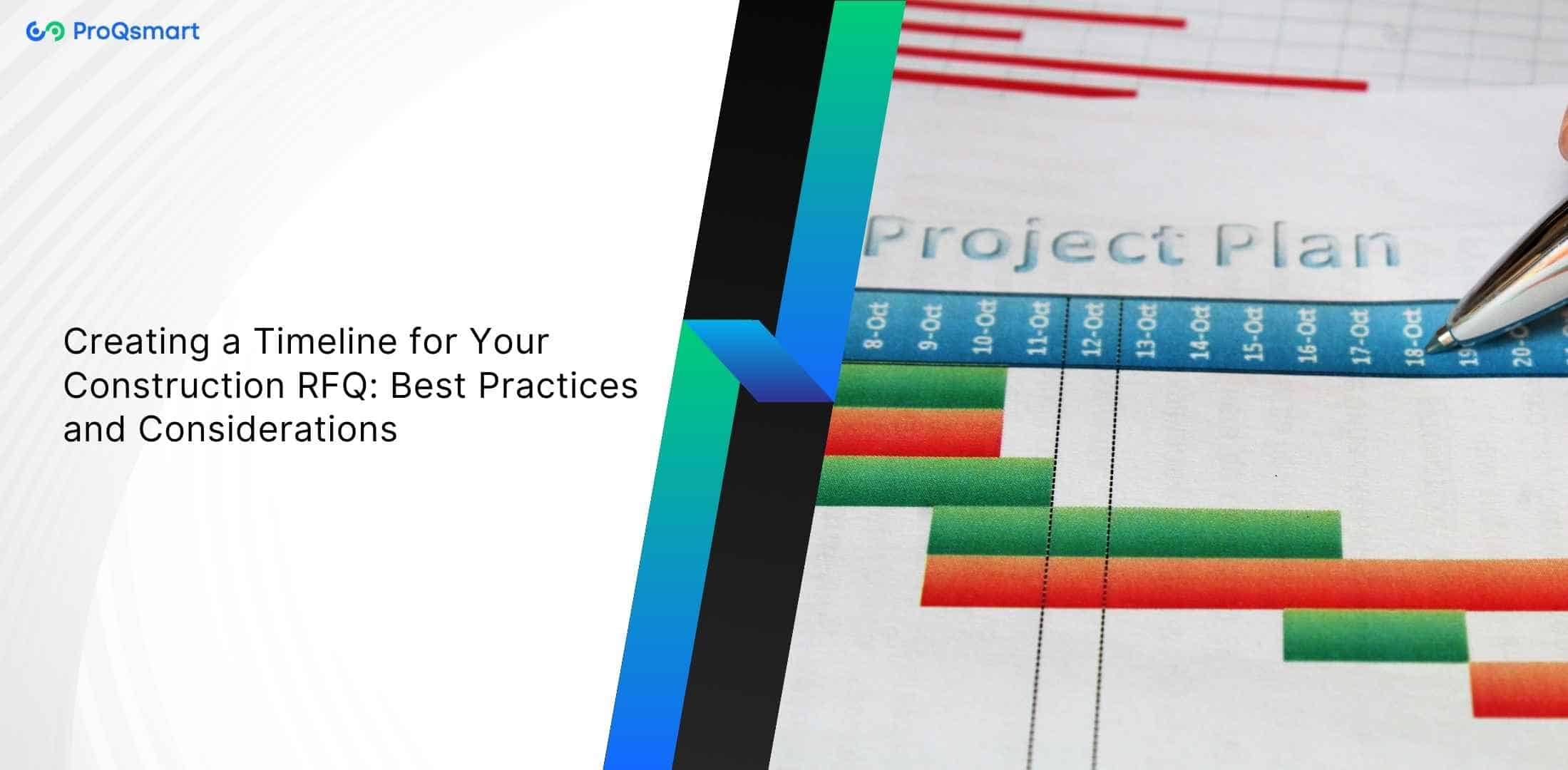Have you ever wondered why some construction projects get off to a flying start while others just seem to stagnate? It all begins with a strong RFQ timeline. A well-crafted timeline lays the groundwork for smooth sailing, providing the structure your project needs to thrive.
Now, let’s get into the nitty-gritty of creating that timeline. We will dive into best practices and key components that make an RFQ timeline tick. Consider the advantages: no waiting around, control over materials, and ensuring everyone is on the same page.
To illustrate these points, we will show examples from other projects. You will gain an efficiency-increasing, stress-reducing roadmap. Let’s make your construction RFQ timetables unstoppable weapons for success.
Are you ready to shift your approach? Jump in and see how it changes your projects.
Key Takeaways
- RFQ timelines are essential for structuring and efficiently managing the procurement process. They allow both suppliers and buyers to effectively align their expectations and deliverables.
- Knowing the important parts of an RFQ timeline is essential to the project process. Be mindful of submission deadlines and evaluation periods for timely actions.
- Building an RFQ timeline takes a lot of time and organizing. Everyone involved should be kept informed of their respective roles and responsibilities throughout.
- When you leverage best practices such as articulateness and adaptability, you open the door to better RFQ results. It also builds better relationships between the parties.
- Well-planned RFQ timelines can greatly simplify construction projects by reducing delays and ensuring smooth transitions between project phases.
- By comparing the RFQ and RFP processes, you reveal the unique contexts in which each one shines. This insight enables organizations to choose the optimal method for their procurement requirements.
Understanding RFQ Timelines
What is an RFQ Timeline?

The RFQ timeline is your roadmap, essential for understanding the RFQ process. It guides you through each phase of the procurement process, ensuring that everything stays on track and aligns with your business needs. Think of it as an ordered itinerary that helps you manage the bidding process efficiently.
This timeline outlines the journey from the initial request for quotes (RFQ) to the final vendor selection. Each phase receives the attention it deserves, allowing you to track your progress and hold yourself accountable to deadlines. It offers a real-time overview of where you stand in the sourcing process.
Typically, a timeline for an RFQ spans six to ten weeks, covering all critical steps. This period takes you from drafting the RFQ document to analyzing supplier bids and ultimately selecting the best prospective vendor.
It’s crucial to avoid overwhelming the process with too many bids. Having more than ten bidders can slow down decision-making and complicate the process. Most RFQs yield the best results with around eight vendors, maintaining competitiveness while ensuring manageable workflows.
Selecting fewer than three vendors might limit your options and reduce your chances of obtaining better price quotations, ultimately making the process less competitive.
Why Create an RFQ Timeline?
Creating an RFQ timeline is crucial because it prevents unnecessary delays. Without a clear timeline, the procurement process can become stalled, which can result in a project delay. A timeline sets the pace, keeping everyone involved on task.
It also helps to hold people on the team accountable and ensures everyone knows their part and what’s needed at each step along the way. Having a structured timeline also helps vendor relationships.
It communicates expectations regarding when and how their bid will be evaluated. This clarity can lead to better communication and collaboration, ensuring both parties are aligned.
When the U.S. General Services Administration needed to set up janitorial services for the entire government, they put out an RFQ (Request for Quotation). This process showed how timelines can shift based on the needs of a project.
The RFQ process begins with clearly defining your needs from potential vendors. Then, you set expectations for their bids and how you’ll evaluate their responses.
A centralized RFX management system streamlines this, so it’s quick and easy to manage RFQ timelines. Then, select a small, pre-vetted group of vendors to streamline your RFQ process. This keeps it short and increases the overall efficiency.
Importance of an RFQ Timeline
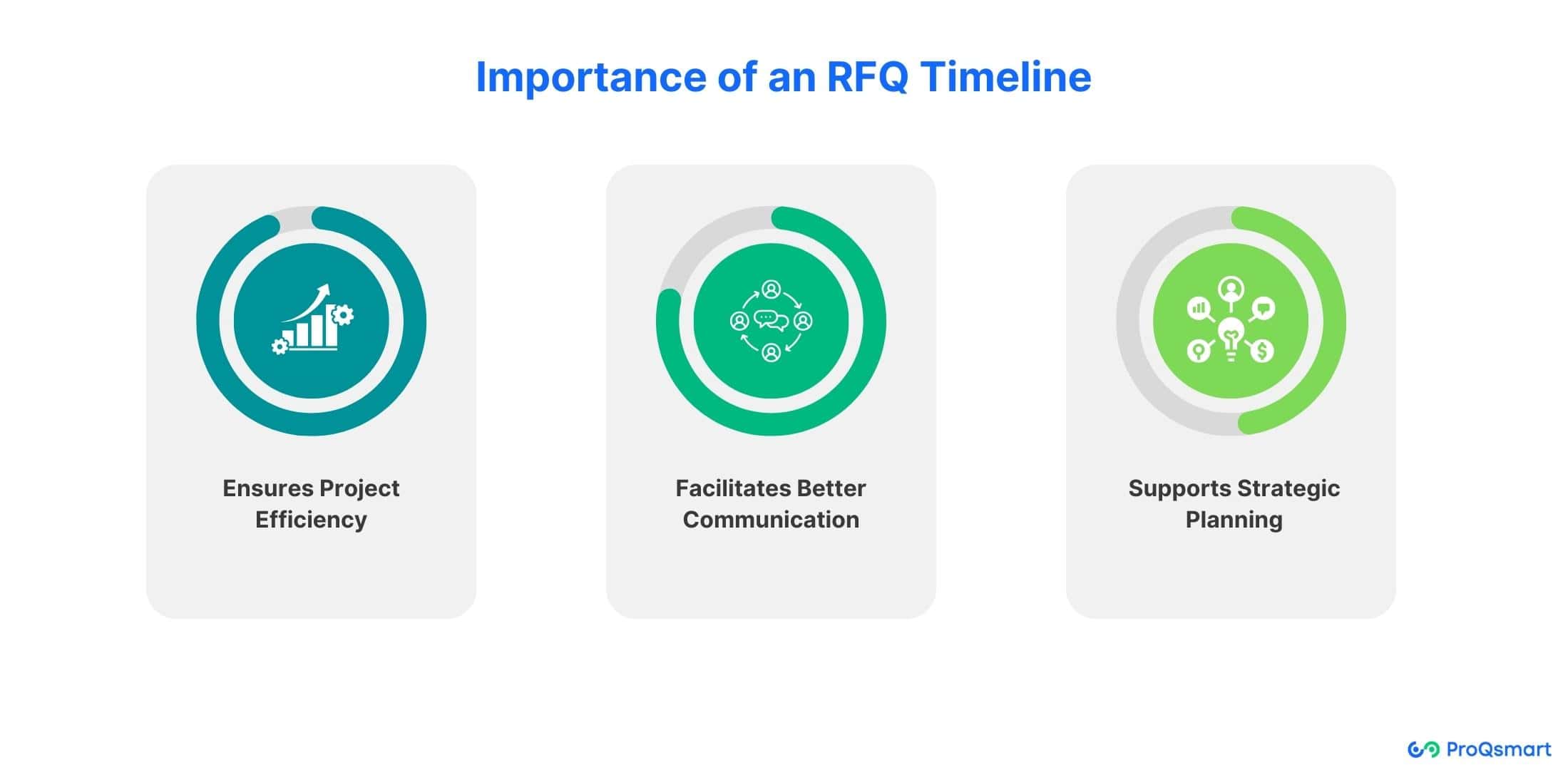
Think of a well-structured RFQ timeline as the spine of a productive procurement process. It frames the entire bidding process, ensuring that everyone has a sense of what’s going on and when. Planning out your day in this way can help make it as productive as possible.
For procurement, this timeline guarantees that project goals and the steps we must follow in sourcing align, creating a smooth workflow. Aligning project goals with procurement activities is essential, and with a clear timeline, you can sync your project needs with the procurement team’s actions.
It’s crucial for everyone to be on the same page regarding deadlines, as this also keeps the project within budget constraints. This timeline will assist you in monitoring your spending throughout the project. Knowing when each procurement step occurs allows for better management of costs, preventing budget overruns and ensuring a consistent supply of goods.
Ensures Project Efficiency
A structured RFQ timeline is key to ensuring that the RFQ process is smooth and efficient. It eliminates wasted time because every step is clearly defined. That way, everyone knows exactly what needs to be done and when.
This clarity helps in making decisions in a timely manner. Everyone knows the deadlines, and decisions get made quickly. Efficiency in the RFQ process translates directly to how fast a project gets completed. If your responses are faster and your timelines are clear, you can get things done sooner.
Facilitates Better Communication
Communication among stakeholders is important. An RFQ timeline is great for this. It gives a clear roadmap that everyone can look at to ensure transparency.
Sharing this timeline with everyone involved keeps them in the loop and aligned. Frequent updates on the timeline are important. Keeping everyone informed with updates will help avoid any surprises.
Supports Strategic Planning
An RFQ timeline supports strategic planning by aligning procurement strategies with business objectives. It helps predict possible roadblocks and plan carefully.
Strategic planning within the timeline can also strengthen vendor relationships by establishing clear expectations. Ian Jennings, a financial advisor, has listed specifics about algorithms in his RFQ timeline. He also points to integration capabilities and data security measures.
Jennings says those need to have timelines built in for complexity and vendor response time. He also offers a Q&A period to avoid misunderstandings and suggests choosing no more than eight vendors. Issuing and managing timelines becomes a breeze using centralized RFX management systems.
Typically, the RFQ has preparation, processing, award, and close, which are all explicitly stated in the time. According to a study, 80% of procurement teams see better outcomes and reduced costs with a well-planned RFQ timeline.
Key Components of an RFQ Timeline
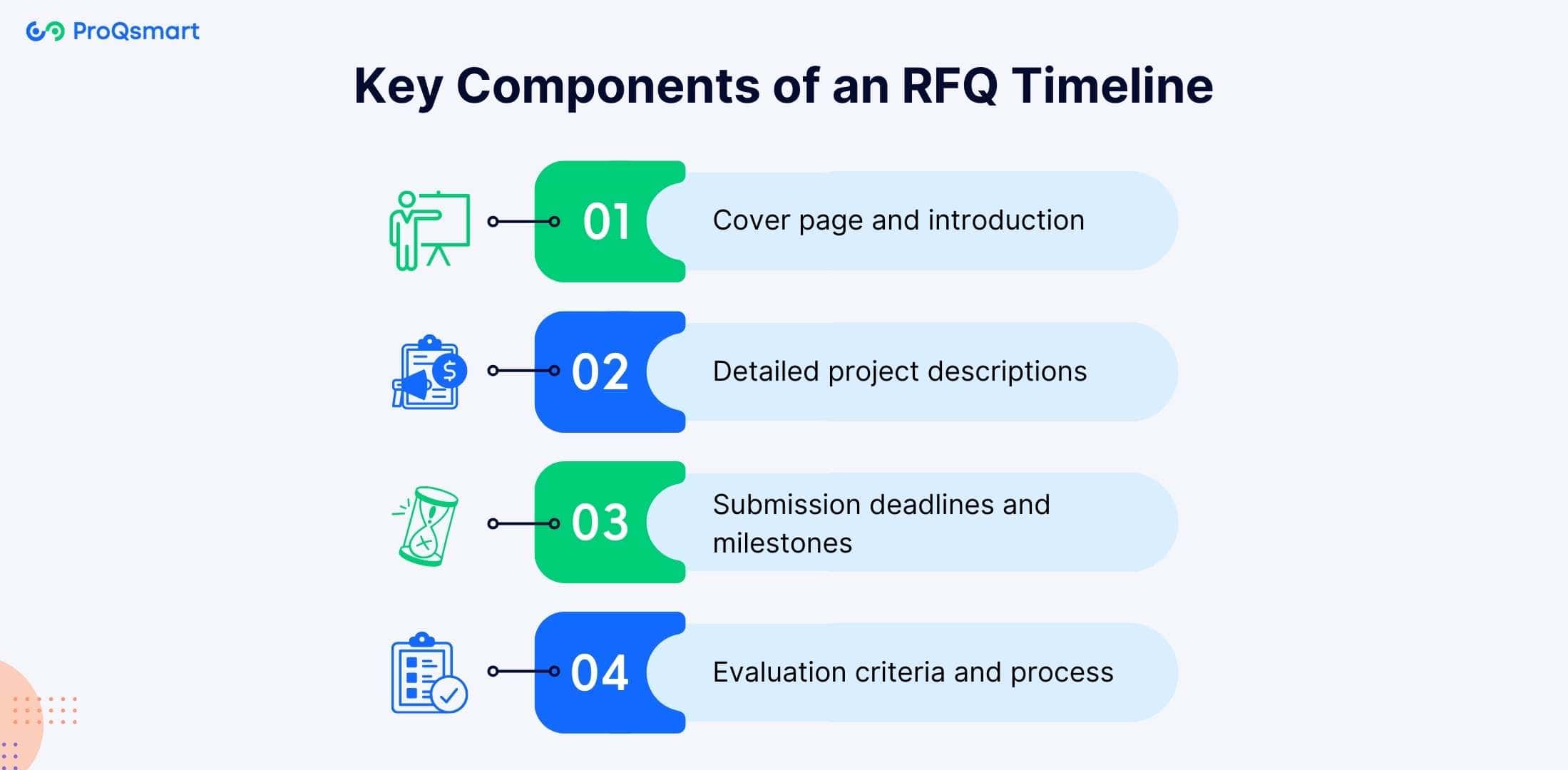
An RFQ timeline is crucial for ensuring a structured and efficient bidding process. Here’s a breakdown of essential components to include.
Cover Page and Introduction
The cover page is your first opportunity to look like a professional. It should present the RFQ timeline clearly, so sellers know at a glance what the document is for.
The introduction gives context, which is a one-page snapshot of the RFQ process. This part is critical, as it establishes the needs and objectives. Including contact info is a must. This allows vendors to find the correct people to contact with their follow-up questions.
The whole thing ends up being much smoother and much more fluid. Consider it your note to potential partners, your guide for collaboration.
Detailed Project Descriptions
There is no doubt that detailed project descriptions are important. They provide potential vendors with a clear understanding of the project scope.
Detailed descriptions help vendors tailor their bids appropriately for the project. By including technical specifications, you help the vendor understand exactly what you need. This ensures the bids you receive align with your expectations, saving time down the line.
For instance, if you’re looking for a software solution, outline the features you need, the number of users it should accommodate, and its integration capabilities. Vendors can write spot-on proposals this way.
Submission Deadlines and Milestones
Deadlines help keep the RFQ timeline moving. Here are critical submission deadlines to include:
- Marks the start of the process.
- Deadline for vendor questions: Allows vendors to seek clarifications.
- The cut-off for bid submissions.
- Keeps the selection process timely.
For smaller RFQs, a two-week timeline can work, giving vendors a fair amount of time to submit thorough responses. That balance ensures thoroughness without dragging the process.
Evaluation Criteria and Process
It’s very important to have well-defined evaluation criteria. It helps you choose the right vendor since it gives you a structured way to evaluate bids.
Outlining the evaluation process ensures fairness and transparency, allowing vendors to put their best foot forward. Include a timeline that outlines each evaluation phase so everyone knows when decisions will be made.
Add a scoring system, and you can make it even more of a data-driven, objective process. For most RFQs, keeping it to eight vendors will likely keep the bidding cost-effective and competitive.
Steps to Create an RFQ Timeline
Developing an RFQ (Request for Quotation) timeline is about putting the planning into each step so the process goes smoothly. Here’s a breakdown of how to do it effectively:
Before we jump into the timeline, it’s important to define what the project actually is. This encompasses the scale, resources required, and end goals. A well-defined scope sets the stage for realistic timelines and helps avoid unnecessary delays.
Involve stakeholders in this process. This way, you can capture all perspectives and needs, so you have everyone aligned from the start.
Setting Clear Goals
Setting clear goals for the RFQ process is essential. These objectives inform the entire timeline and ensure it stays connected to the overarching project goals. If your project goal is to pick a vendor that can offer quality at a low cost, make sure your RFQ goals demonstrate that.
Bookend the timeline with intense evaluation periods so that the process moves toward a more likely vendor fit.
Break Down the Timeline
Break down the timeline into key milestones such as RFQ issuance, a vendor inquiry period, submission deadlines, and evaluation completion. This helps to track progress and ensure that each phase of the RFQ process is completed on time.
For example, offer a 2-3 week response window for vendors, so that they can take the opportunity to make full bids. This is important, particularly including a Q&A period to minimize misunderstanding.
Smart Resource Allocation
Smart resource allocation is of great importance. Assign roles and responsibilities within your team to avoid bottlenecks. Allocate resources based on each team member’s skills and workload.
This way, we get things done fast, but no one ends up feeling overworked. Implementing a centralized RFX management system can make this process a breeze, allowing you to easily track tasks and allocate resources.
Regular Updates
Keep updates regular, and lines of communication to stakeholders open to maintain interest and engagement high. Timely updates address concerns and incorporate feedback, avoiding potential roadblocks.
This collaboration creates a feeling of ownership among stakeholders, increasing the likelihood of project success.
Including these steps makes for a complete RFQ timeline. It’s better to wait for 3 to 8 responses to get better bids.
Turn to tools such as a parametric cost estimation template for accurate budgeting. A large library of templates streamlines the work so you can check each milestone off the list.
Best Practices for Effective RFQ Timelines
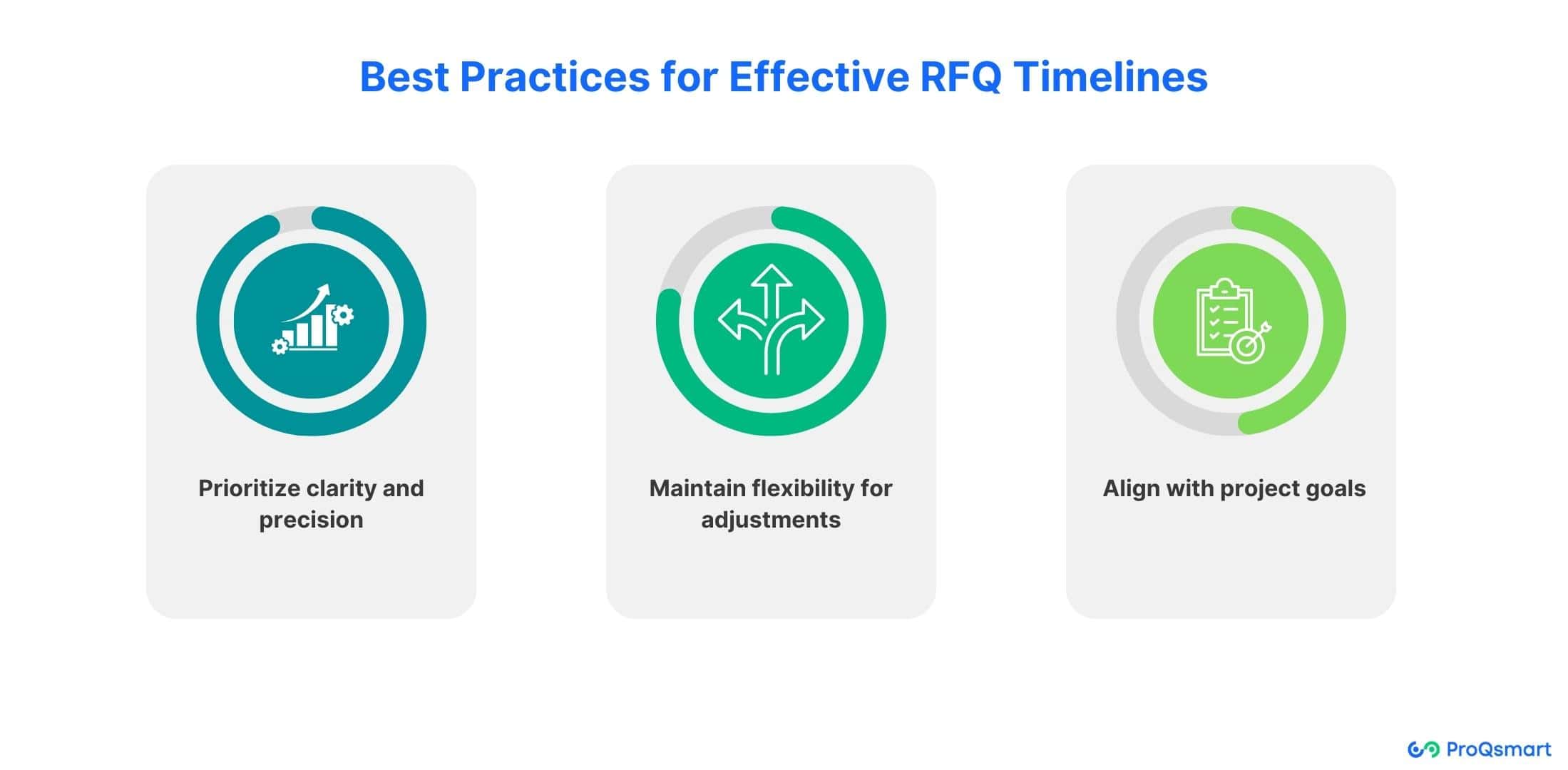
Designing a timeline for my RFQ (Request for Quotation) is essential to keep the whole bidding process on track. Here’s a bullet list of best practices to guide you.
- Prioritize clarity and precision
- Maintain flexibility for adjustments
- Align with project goals
Prioritize Clarity and Precision
In the universe of RFQs, clear language and specific details are crucial in your timeline. When you spell out every step, leaving no room for interpretation, you reduce misunderstandings among your team members and vendors.
Imagine writing an RFQ with no ambiguity whatsoever. That’s what clarity does — it gets everybody on the same page, from the beginning. Concise documentation supports effective communication. By including submission requirements and deadlines in the RFQ document, vendors know exactly what’s expected and by when.
Ian Jennings, the founder of Harbour View Mortgages, places importance on clear timelines. He makes sure they capture both the nuance of our needs and the time that vendors need to respond in detail. This approach ensures you and your vendors are on the same page, setting the stage for successful interactions.
Maintain Flexibility for Adjustments
Flexibility is key to a successful RFQ timeline. Leaving space for unexpected shifts allows you to adjust accordingly. This adaptability underpins the procurement process, making it more robust and responsive.
You’ll want to review the timeline regularly, which also allows you to update it if needed. Every quote request is unique, so be flexible with your timeline. Consider the time that the vendor needs to develop a comprehensive response — typically allowing 2-4 weeks. This flexibility allows for a smoother, less stressful process for both parties involved.
Align with Project Goals
Aligning the RFQ timeline with broader project objectives is crucial. This alignment increases stakeholder buy-in and support — everyone is working toward the same end goal.
During the RFQ timeline creation, it’s key to review the project goals to stay aligned. In doing so, you set a realistic timeline for when the awarding phase begins (after the submission deadline is closed).
Furthermore, specifying the timeline for making a decision and reviewing proposals in the RFQ document will provide a clear framework for evaluation. This practice strengthens stakeholder confidence and commitment, fostering a collaborative environment essential for project success.
Factor in the entire time needed for contract negotiation to make sure all phases are covered thoroughly.
Benefits of a Well-Planned RFQ Timeline
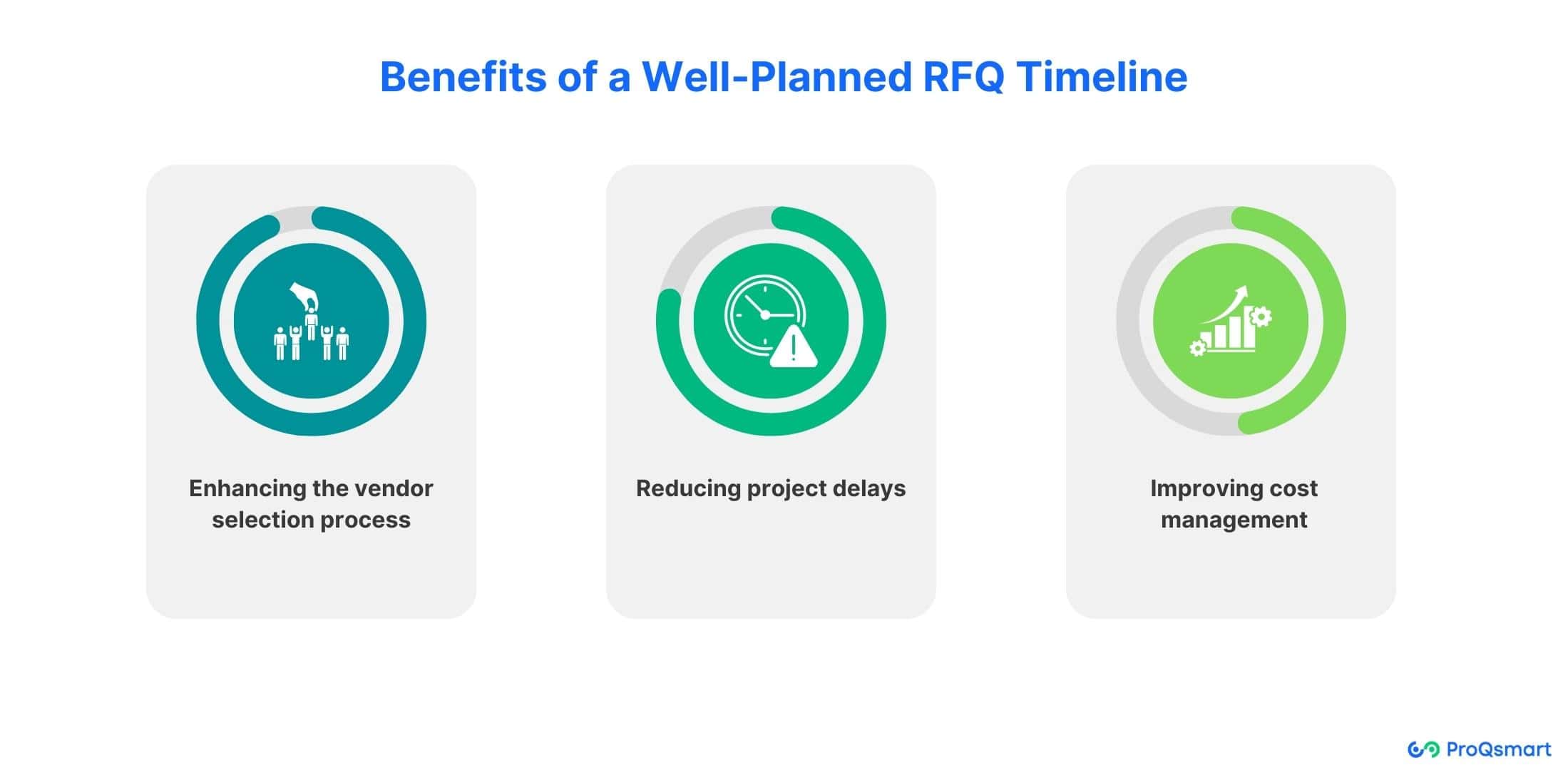
A well-planned RFQ timeline offers numerous advantages that can significantly enhance the efficiency and outcome of procurement processes.
These advantages include:
- Enhancing the vendor selection process
- Reducing project delays
- Improving cost management
Enhances Vendor Selection Process
When you have a well-structured RFQ timeline, it simplifies how you evaluate vendors. Having clear deadlines and defined stages enables you to fully explore each vendor’s offering. This way, you ensure that you select the optimal option for what you need.
Timely evaluations are important, as they ensure that you secure competitive bids. Vendors are much more ready to make their best offers when they become part of an orderly and timely process. Knowing this motivates them to try to put their best proposals forward.
This approach attracts more qualified vendors who are confident in meeting your expectations. When suppliers realize they’re competing, they go into action and reduce their prices to offer maximum value. This strategy goes a long way toward improving bid quality.
Consequently, you find an improved choice of vendors and, ultimately, higher project quality and compliance.
Reduces Project Delays
A good timeline minimizes the bumps in the road. The risk of project delays decreases significantly when each phase of the RFQ process is completed on time. There’s a big correlation between on-time RFQ processes and project success.
You want to see a project through to a successful finish. Proactive timeline management is your friend here, preventing the pitfalls from occurring. Stalling on the vendor selection is a big pitfall to avoid.
Timely vendor selection ensures that materials and services are available when needed, which keeps your project on track and within the projected timeline.
Improves Cost Management
A well-planned RFQ timeline is a great weapon for driving down costs. If you pick out your vendors early on, it is much more likely that you’ll keep it within your budget. Timely vendor selection directly impacts your ability to stick to your budget.
It’s about incorporating cost analysis directly into your timeline. When suppliers realize they’re in a competitive space, they offer their best prices, thus preventing you from overpricing.
In studies, businesses using planned timelines report lower procurement costs. This tactic can help you secure more favorable terms that save you money and increase your profit margins.
You’ve streamlined the process to procure it, so it’s a win/win for your organization.
Comparing RFQ with RFP
To help you understand the differences between RFQs and RFPs, let’s compare them based on key features in a streamlined RFQ format.
Feature | RFQ (Request for Quotation) | RFP (Request for Proposal) |
Purpose | Focused on obtaining the best price for known items. | Gathers detailed proposals when you’re unsure of needs. |
Information Required | Basic details: price, delivery time, terms. | Detailed info: features, benefits, plans. |
Typical Use Cases | Straightforward purchases, like office supplies. | Complex projects, like software development. |
Differences in Purpose and Use
RFQs and RFPs may sound alike, but there are key differences. An RFQ is focused on getting the best price for an item you actually require. If you’re establishing a new workspace, you’ll want to price out office chairs.
This makes RFQs ideal for simple purchases without a lot of hassle. On the other hand, RFPs are important for managing complex projects. For example, they help you select a vendor for a new IT system.
You’re not simply focused on the price. You’re also assessing the vendor’s approach, how well they understand your needs, and the solutions they offer. RFPs expect a much higher level of detail. They are thicker and harder to read than short RFQs.
Information Required for Each
When putting together an RFQ, the typical information you need to include is as follows:
- Product specifications: Details about what you’re buying.
- How much you need and when.
- Pricing information: Cost details for comparison.
- Payment terms: How and when you’ll pay.
This list is much shorter than what you would typically have for an RFP. You do a lot more exploration in an RFP, including implementation plans and expected benefits, so it ends up being a bit more elaborate.
When to Choose RFQ Over RFP
Knowing when to use an RFQ instead of an RFP can save you valuable time and effort. If you know exactly what you need, pursue an RFQ to compare price.
This approach is great for buying bulk stationery or standardized equipment. It’s faster and only concerned with finding you the best deal. According to a study, 80% of companies prefer to use RFQs to find the best price.
The RFQ process is quick and easy. It’s ideal for simple buying decisions and makes it easy to compare vendors. Have your financial data at the ready. It helps paint a full picture for potential suppliers so they can create more accurate quotes.
Examples of RFQ Timelines for Construction Projects
When we discuss RFQ timelines in construction, particularly in the context of the bidding process, it is essential to understand how they apply to various projects. Below, we’ll explore timelines for residential building projects and commercial infrastructure developments, including small home renovations and new single-family houses, as well as timelines for office buildings or massive retail complexes.
Residential Building Projects
Residential projects have different RFQ timelines for specific business needs.
- Residential timelines may also need to take local building codes and zoning rules into account. These regulations can vary significantly, influencing the speed at which a project proceeds. If you build a new home, it’s even more complex because permits are needed locally. The process is often more complicated than in a rural location.
- Incorporating local regulations in the RFQ timeline is vital. If you forget these, it can cause you delays or cost you money. A BOQ serves as an important tool by presenting a detailed listing of materials and labor. This allows you to plan your advertisement accurately and make sure you are in accordance with local laws.
- It’s crucial to communicate clearly with subcontractors. Miscommunication will result in mistakes or rework. Think about using a centralized RFX management system. This can expedite the process to make it easier to manage several RFQ submissions at a time.
Commercial Infrastructure Developments
The RFQ process can be more complex when it comes to competitive bidding for commercial projects. Let’s dive into the details.
- Commercial projects generally require more detailed and prolonged timelines. That is because they often entail greater scale and more stakeholders. A commercial office building timeline includes essential steps such as environmental assessments. These steps aren’t usually necessary for residential projects.
- The complexity of commercial projects demands precise timelines. A detailed RFQ is essential to manage these complexities, ensuring all parties are aligned on expectations and deliverables. BrightRidge leveraged an RFQ to purchase complex equipment for their business. This is an example of how setting clear timelines can support complex procurement needs.
- Engaging stakeholders is crucial. With all these parties from architect to local government, timelines must reflect everyone’s input. RTI International acquired new tech using an RFQ. This approach ensured all needs and expectations were fully in place.
Conclusion
To nail the RFQ, timing is your best friend. You plan right; you win big time. It’s like how you would prepare your favorite meal. You need all the ingredients, but you need to know when to add each one. With RFQ timelines, it’s about knowing when to send what. This helps expedite the decision-making and alleviates the stress. It’s all about sharp moves and smart plays.
Follow these steps and tips, and you’re on your way to impressing with every RFQ you handle. Get in there; get into those timelines. Use them to show your worth and to make great connections. Never underestimate the power of time management in the RFQ game. Take these insights and go make that magic happen. You want to take it a step further, right? Go deeper and see how far you can go with our guides.

